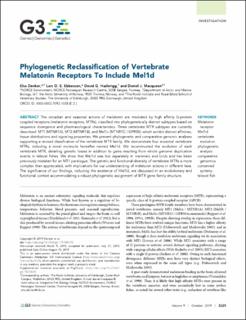| dc.contributor.author | Denker, Elsa | |
| dc.contributor.author | Ebbesson, Lars O.E. | |
| dc.contributor.author | Hazlerigg, David | |
| dc.contributor.author | Macqueen, Daniel J. | |
| dc.date.accessioned | 2020-03-25T14:46:01Z | |
| dc.date.available | 2020-03-25T14:46:01Z | |
| dc.date.created | 2019-10-23T18:51:46Z | |
| dc.date.issued | 2019 | |
| dc.identifier.citation | G3: Genes, Genomes, Genetics. 2019, 9 (10), 3225-3238. | |
| dc.identifier.issn | 2160-1836 | |
| dc.identifier.uri | https://hdl.handle.net/11250/2648658 | |
| dc.description.abstract | The circadian and seasonal actions of melatonin are mediated by high affinity G-protein coupled receptors (melatonin receptors, MTRs), classified into phylogenetically distinct subtypes based on sequence divergence and pharmacological characteristics. Three vertebrate MTR subtypes are currently described: MT1 (MTNR1A), MT2 (MTNR1B), and Mel1c (MTNR1C / GPR50), which exhibit distinct affinities, tissue distributions and signaling properties. We present phylogenetic and comparative genomic analyses supporting a revised classification of the vertebrate MTR family. We demonstrate four ancestral vertebrate MTRs, including a novel molecule hereafter named Mel1d. We reconstructed the evolution of each vertebrate MTR, detailing genetic losses in addition to gains resulting from whole genome duplication events in teleost fishes. We show that Mel1d was lost separately in mammals and birds and has been previously mistaken for an MT1 paralogue. The genetic and functional diversity of vertebrate MTRs is more complex than appreciated, with implications for our understanding of melatonin actions in different taxa. The significance of our findings, including the existence of Mel1d, are discussed in an evolutionary and functional context accommodating a robust phylogenetic assignment of MTR gene family structure. | |
| dc.language.iso | eng | |
| dc.rights | CC BY 4.0 | |
| dc.rights.uri | https://creativecommons.org/licenses/by/4.0/ | |
| dc.title | Phylogenetic Reclassification of Vertebrate Melatonin Receptors To Include Mel1d | |
| dc.type | Peer reviewed | |
| dc.type | Journal article | |
| dc.rights.holder | Copyright © 2019 Denker et al | |
| dc.description.version | publishedVersion | |
| cristin.ispublished | true | |
| cristin.fulltext | original | |
| cristin.qualitycode | 1 | |
| dc.identifier.doi | 10.1534/g3.119.400170 | |
| dc.identifier.cristin | 1740009 | |
| dc.source.journal | G3: Genes, Genomes, Genetics | |
| dc.source.volume | 9 | |
| dc.source.issue | 10 | |
| dc.source.pagenumber | 3225-3238 | |

